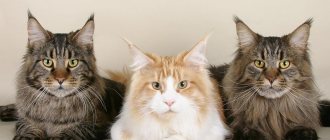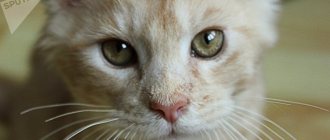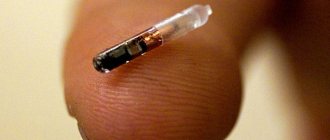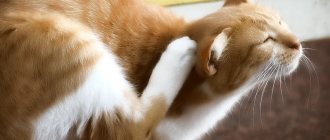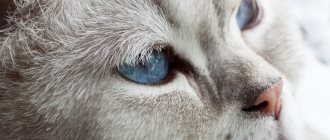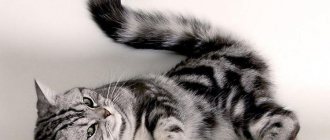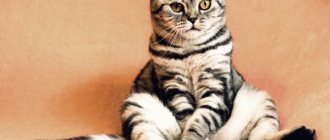Pipe tail
This is a very good sign in domestic cats. It means the pet’s high spirits, its readiness for communication and active games. This situation indicates that the cat likes everything, she is cheerful and calm. During such a period, you can safely take out cat toys and start playing with your pet - the animal will appreciate it. If a cat greets its owner from work and has a tail like a pipe, you can be sure that it adores its owner.
How to tell a cat's mood by its tail?
5778Administration
Cats also try to talk to people. They express their thoughts through movements. You can easily determine a cat's mood by its tail; you just need to know what its certain movements mean.
If a pet lives in the same house for a long time, then the owners already know its behavior and can understand it. They communicate in a special sign language using their tail.
© shutterstock
Everyone knows that the tail is responsible for its owner’s coordination, balance and dexterity. Also, experts agree that the tail serves as a kind of “steering wheel” for the pet. During sudden movements, when running, when turning, it helps to maintain balance and prevents it from falling.
And of course, you can determine the cat’s mood by its movements, position and rotation. It is worth paying attention to it often and you will be able to unravel your pet.
Pets try to describe their state and mood with their tail quite often, thus communicating with their owner and expressing their feelings.
“Cat language” is various movements of the tail. To understand your pet well you need to know the following: :
- if a cat waves its tail in different directions, it means that it cannot choose one between two desires. If the tail is calm, then the cat has made up its mind;
- the position of the tail is exactly vertical - this may indicate extreme interest in some new object or person;
- slight twitching and movements of the tail indicate love, feelings of tenderness at the moment;
- if the animal has its tail down, then it is bored and wants entertainment and games;
- if the tail is raised up, the body is curved, and both ears are pressed to the head, this means that the fluffy is in a frightened state, ready to attack, but doubts whether to attack or run away from the impending danger;
- if the tail is raised up and slightly bent in an arc, this is an indicator of approaching danger. The pet is ready to defend itself at any moment, and if it is touched, it will easily scratch anyone;
- a vertical tail up means that the four-legged animal is in a good mood, is glad to see you and wants to play;
- the tail is down and in a free position - the cat is completely calm, but does not want to communicate;
- if, however, the tail constantly moves horizontally in different directions - this is how the cat expresses its dissatisfaction and irritation. It's better not to touch him;
- a tousled but freely dangling tail indicates alertness;
- the good mood of the domestic cat, its satisfaction with life and complete relaxation - movement only with the tip of its tail;
- if the tail moves slowly from side to side, and its speed increases all the time, then the pet is ready to attack the victim and this is about to happen.
© shutterstock
When you pet your pet, he arches his back, stretches out his tail and claws - he definitely likes what you are doing.
The pose of a furry pet also speaks volumes. If a cat looks into a person’s eyes and has its tail raised high, while its legs are straight and its back is straight, it wants communication. At such moments you should not ignore him, push him away, you need to give him time, play, pet him, talk to him.
The tail of cats is a means to fully express their feelings, emotions, state, experience and other states. Using it, you can quite easily and accurately determine your pet’s mood and feelings. To do this, you need to know the basic movements that a cat performs.
When running, the so-called “fifth limb” of the animal gives it the ability to clearly maintain balance.
But, there are also types of cats that can do all this without a tail, since they are significantly shortened at birth.
IMPORTANT!
VETERINARIAN CONSULTATION REQUIRED. INFORMATION FOR INFORMATION ONLY. Administration
Share with friends
Article rating
(1 ratings, average: 5.00 out of 5)
Light twitching
6 life hacks to always keep your cat's litter box clean
But this is not a very good sign. If a cat stands still and the tip of its tail twitches, this may mean that it does not like what is happening, is irritated or even angry. During such periods, it is better to either remove the source of irritation or move away from the animal, because it is about to sink its claws into the culprit of her bad mood.
Stress or fear
Please note that the animal, being in a relaxed, lying state, may well keep its tail down, even with a curved tip.
However, keep in mind that if the cat does not pick it up throughout the day, this is the most obvious sign of a violation, which, by the way, may have a psychological basis.
So, according to our veterinarian, cats often keep their tail down in moments of fear or stress. True, if it seems to you that the reason for your pet’s drooping tail is precisely fear, pay attention to exactly how he holds it: such an emotion is never accompanied by the passivity of the tail - it is in a tense state, slightly raised at the base.
Thanks to my observation, the health problem of my beloved cat was resolved in a timely manner. I also advise you to be attentive to the health of your pet and, as soon as possible, immediately take him to a specialist.
Found a violation? Report content
The tail is fluffy and looks like a bottle brush
The cat has a broken tail: what to do?
A fluffy tail means the cat is scared. This way she wants to appear bigger, while at the same time she can fluff up the fur all over her body. Sometimes it is difficult to predict what particular event or object may frighten a cat, but if this suddenly happens, then such a position of the tail will allow the owner to remove the irritant from sight and calm the pet.
Nerve problem
In our case, the cat encountered just such a problem. As the veterinarian said, the animal has a slight disturbance in the formation of the spine, which led to a pinched nerve.
According to the specialist, this is a fairly common problem that is often encountered by animals in the active growth phase.
I would like to appeal to all owners of cats and kittens: be careful and monitor the health of your pet, because if you ignore this problem, it can develop not only into a constant feeling of discomfort for the pet, but also into a curvature of the spine, underdevelopment of the chest, or even cause crooked paws.
In the summer I cook red borscht with “raw” currant jam: it turns out delicious
The pictures appear to be of food, but they are actually crystals.
You can tell what kind of father a man will be even before the birth of the child.
Tail down
Not the best position for a cat's tail. It means that the furry pet is very angry and is ready to attack and fight. It is worth taking a closer look at the environment and finding out what made the animal so angry in order to eliminate the problem and calm it down. Sometimes this situation may just be a feature of the breed, as in Persian cats, for example.
Congenital disorders
In outbred cats, health problems are much less common than in their “blue-blooded” relatives. The reasons are the illiteracy of people who call themselves breeders, close inbreeding, gene mutations and much more.
If a cat tucks its tail under itself from birth or at a certain age, the reasons are developmental disorders. The most common cause is a twisted tail , that is, the fusion of two vertebrae, which leads to tension (and subsequently atrophy) of the muscles and tendons.
Note! If an adult cat cannot lift its tail and constantly tucks it, contact your veterinarian immediately. It is highly likely that your pet has suffered a vertebral displacement or another ailment affecting the spine.
A kinked tail has a mitigating circumstance - incorrect positioning does not cause pain . However, there are also serious disadvantages - the cat cannot fully use its tail to maintain balance and communicate. Simply put, in the wild, a four-legged animal would not survive with this harmless marriage, but in an apartment it can live fully, happily ever after.
What is a cat's tail?
The cat's tail is an extension of the spine. From the junction of the largest vertebra with the tip, smaller vertebrae begin to branch off. At first glance, the ponytail of a domestic beauty is so simple. But the cat has an incredibly flexible tail, which it can deftly bend and wag in different directions. This happens due to the fact that between the cat’s vertebrae there are joint spaces in which a kind of gel substance is located. This substance allows the vertebrae to lubricate each other and smoothly move the tail in all directions.
The length of the tail in cats can be very diverse and varies
from 20 to 40 cm! It is not for nothing that a cat is endowed with a tail; biologically, it helps her maintain balance and remain graceful in any situation. Thanks to their tail, cats can successfully hunt, getting their food in the wild, and the tail also helps the cat land on all fours. Cats, deprived of a long tail as a result of selection, have longer hind legs, which also help them land skillfully when jumping.
Curved Down
An arched and downward-curved cat's tail, resembling an inverted "U", indicates that the animal is preparing to take a defensive position.
If at the same time the cat begins to move smoothly, semi-sideways towards the source of visible danger, you should know that the defensive stance and state of tension will quickly turn into defensive aggression, and the temperamental animal may well suddenly begin to attack.
Injury
If a cat's tail hangs, you need to remember what the animal did shortly before. Most often, this results from an injury received during an unsuccessful landing. Also, the tail could have broken from being severely pinched by a doorway.
You can check the fracture yourself. To do this, you should observe the animal. A curled tail in cats will hurt and cause discomfort.
If there is a fracture, the problem will have to be solved by simply waiting. The fracture can be fixed with a special bandage or plaster. In some cases, your veterinarian may prescribe an antibiotic and anti-inflammatory medication.
If an x-ray does not reveal a fracture, but the problem began after a fall, a specialist will diagnose a bruise. It will take time for a hanging tail to recover.
Emotional factor
Emotional factors should be highlighted separately:
- First of all, it is a state of aggression. With its tail tucked, the pet feels protected. The animal also whips itself on the sides with the tip of its tail for a larger radius of protection;
- in a state of fear, the pet tries to shrink as much as possible. A female individual can thus protect offspring from possible danger. Numerous beatings and fights also intimidate the cat, as a result it shrinks into a ball;
- During sleep, the animal curls up into a ball. This is considered the most comfortable and protected resting position.
Nerve rupture
If a cat's tail hangs after a collision with another animal, then there is a possibility of a nerve rupture. If this happens, the pet will not only not be able to control part of the body, but its tail will not respond to external stimuli.
© shutterstock
Doing anything on your own is useless. You can't do it without qualified help. The damaged tail will most likely need to be amputated to prevent complications.
Horizontally mounted
A cat experiencing ambiguous sensations, in a state of tension and increased concentration, straightens the body of its body as much as possible, moving its tail back. The slightly twitching tip of a cat's tail, which is in line with the animal's body, betrays its anxiety and self-doubt.
The pet is confused and is not yet able to assess the surrounding situation. However, this will take him no more than a few seconds. Perhaps he will react quite unexpectedly, sharply and not always favorably for the person.
To avoid this, the owner must immediately try to show his disposition and sympathy for the animal, convincing him of the harmlessness of his intentions.
With soft intonation, an insinuating, calm voice and smooth movements, you can relax and distract your pet, letting him know that there is no source of any threat nearby.
Tail tucked between hind legs
If the tail is tucked between the hind legs, the cat is probably frightened by something, as if a person's eyes suddenly widened from something he saw or heard. Loud or unusual noises, unfamiliar people or animals suddenly appearing on your pet's territory - any of these events can cause such a reaction. But if nothing unusual is happening around, this gesture may mean that the animal is concentrating its attention on something interesting to it, for example, on the appetizing aroma of fish.
Eye movement. Glances and gestures
Cat
, sitting near the door with her head raised, makes it clear that she wants to enter.
But if she sits near the door with her eyes downcast, her posture means that there is someone behind the door. Some cats
, trying to get out of the house, jump on door handles and, after a little practice, open them, and sometimes not only the usual ones, operating on the principle of a lever, but also round ones.
According to stories, cats
can be taught to use a door knocker.
After knocking on the door, they sit down and patiently wait for it to be opened. Some cats
rush at people who enter the house without knocking or in an unusual way, that is, they behave like watchdogs.
If you had to punish a cat
, the animal can express its displeasure by turning its back to you and starting to brush its fur.
This gesture
is designed to get you to fuss around her until she finally condescends to answer. Then your pet will be naughty a little more, happy that the troubles are over and forgiveness has been received.
Cat behavior
largely depends on her upbringing, which should begin from an early age.
If you make
some concessions
for a kitten cat
, since it
is almost impossible to wean her from what she was used to in childhood.
First aid
A pet's hanging tail is the first sign that any disease is beginning. It may be associated with a nervous disorder or be a harbinger of physical illness. Neglected treatment or its absence will lead to complications and deterioration of the cat’s health.
If your cat has a drooping tail, then first you need to feel it from the base of the tail to the tip. A cat’s painful reaction to touch signals the onset of the disease. A veterinarian will provide effective assistance, and you should try to determine whether the tip of the tail is broken or whether there are any wounds. In case of a fracture, a tight bandage is applied, and if scratches are noticeable, then the wound needs to be treated. Also, one of the reasons for this ailment is nerve rupture. The presence of a gap is determined by inspection of the tail.
If it does not move entirely, but, for example, only at the base and tip, and the middle reaches towards the floor and is in a hanging state, then this diagnosis will be confirmed. Also, do not forget about the emotional trauma of your pet. In the event of the loss of a beloved owner or the loss of offspring, he will be in a state of stress. At such moments, it is especially important to show your love and care, otherwise the cat’s tail will droop and body disorders may begin.

